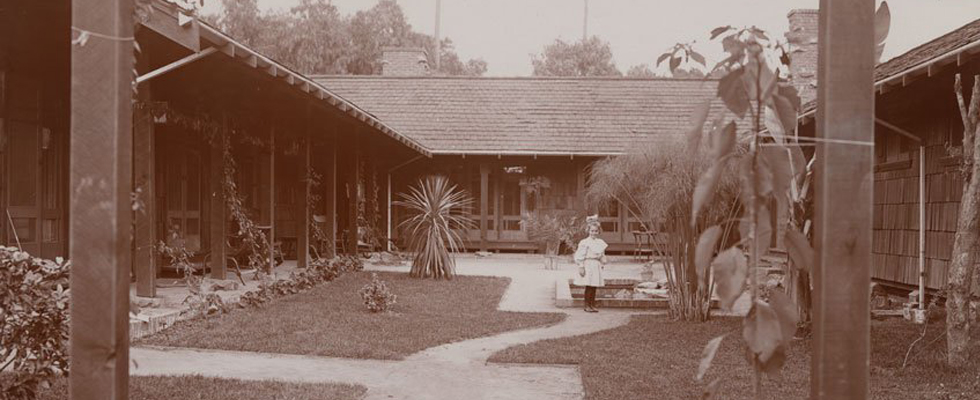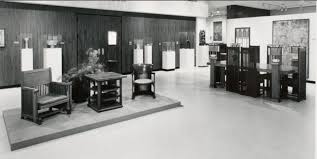Some of you may have read the article in the April issue of Los Angeles Magazine about the Greene and Greene house that was dismantled and moved to Canada. The week of June 22nd Ted Bosley, James N. Gamble Director at the Gamble House, will take a road trip to Alberta Canada to examine the remains. Like us on Facebook to follow Ted on his journey to rediscover this “lost” Greene and Greene.
How a Long-Lost L.A. Home Was Found 1,770 Miles Away
Revered architects Greene & Greene built the house in a nascent Hollywood. For years its fate would be a mystery to all but a few
With Guillermo gone and their older sister, Theodora, leaving to get married, the project fell to Victor, Christine, and Winona. Ranging in age from 21 to 26, the Storer children made up in enthusiasm what they lacked in skills. (“You know what young people are—they think they can do anything,” Winona reflected in 1966.) Armed with chisels, crowbars, and hammers, they began taking the structure apart over the summer of 1917, beginning at the rear and working their way forward. As each board was removed, it was labeled and stacked in the growing pile in the courtyard. For the heavy roof beams Victor enlisted the help of a friend from Hollywood High School who, according to Winona, was “simply thrilled” to be among the few who knew of the adventure. The family wanted to keep the project a secret. “Nobody knew what we were doing,” Winona said into the tape recorder.
Gail tried to wrap her mind around the idea of amateurs dismantling an entire house, including the electrical wiring and plumbing.

By the time reporters had learned of the story, three massive chimneys were all that remained of the residence. MOVING TO CANADA, WILL TAKE BIG HOUSE ALONG read the headline in an August 21, 1917, edition of the Los Angeles Times. “The most extraordinary feat of house moving in the history of such things so far as known,” the article declared. The hundreds of tons of disassembled structure would be transported in four 40-foot railcars to Millet, Alberta.
In the same way they were unwilling to relinquish their home, the family opted to take their animals with them as well. While the rest of the Storers traveled north by boat and passenger train, 19-year-old Victor shepherded the animals onto the freight train that carried their house, a loaded pistol by his side as protection during the two-week journey. The audiotape crackled as Winona recounted how the trip’s only casualties proved to be the goldfish, which were lost when a sudden jolt sent their bowl flying out of the open boxcar door.
Fall was already descending on Millet when the train carrying the Storers slowly puffed into town on a September day in 1917. Surveying the broad, empty landscape of their new home, they experienced a profound sense of culture shock. “I thought it was the end of nowhere,” recalled Christine. But any sense of remorse over their circumstances was dispelled by the urgency of the moment. Far from the balmy weather of Hollywood, the Storers didn’t have time for self-pity; they needed to race against the onset of winter.
Some nine-and-a-half miles to the east of Millet, in an area known as Cloverlawn, the family established itself on a picturesque 640-acre plot they named the Silver Water Ranch. The plan was to turn this raw wilderness “with lots of sloughs and heaps of trees,” as Winona described it, into a working ranch with crops and cattle. They set up a canvas tent as temporary shelter. What the family didn’t know was that arctic air masses blasting the province could drive the temperature down to -58 degrees, but as the November winds began blowing, a neighbor offered the use of a small shack he’d put up when he had homesteaded his land. “We couldn’t stand upright,” said Winona, “but it didn’t matter; it was covered and warm.”
Despite the brutality of their first Canadian winter, the Storers concluded that the house would have to wait. A barn, critical for ranch operations, took precedence. Getting the lumber from the Millet depot to the ranch fell to Victor and Winona—“a ghastly job,” she said—as Christine stayed behind, breaking up stones for the barn’s foundation. During the hauling operation, one of the workhorses bolted and trampled Winona, injuring her to such an extent that she would require a wheelchair for much of her life. Not that she would waste time recovering; there was a barn to be built, and she insisted someone push her up the ladder so she could install shingles on the roof.
Working through spring and summer, the Storers brought in laborers—a first—that autumn to finish the barn in order to move in before winter. It would be Juan’s last. By the following June he had died and was buried near the pretty hill on which the family was now beginning to reconstruct its home.
With World War I at an end, workers were to be had in abundance, but quantity did not mean quality in the eyes of Winona and Christine. “They were so unskillful,” Winona said, that the family took to calling them “wood butchers.” Throughout the summer and into the fall of 1919, the sisters waged an endless battle with the workers, admonishing them for ignoring the carefully placed markings on the boards: “You can’t have that piece up there—that’s the dining room. That belongs to the drawing room.” Finally they had had enough and fired the lot of them. “We finished it all ourselves,” said Christine.
Winona, who had once considered pursuing a career in architecture, had no qualms about reimagining Greene & Greene’s design to fit the family’s needs. “Oh, she adapted it. Architected it all again,” Christine said with admiration into the recorder. Winona’s version hardly resembled its Hollywood incarnation, with practicality winning out over aesthetics from most every angle.
After more than two years with no electricity or indoor plumbing, the family was able to move into the house in December of 1919. Out from their crates came the two grand pianos, original oil paintings, antique rugs, furniture, and other possessions that had accompanied the family on its journeys. But one critical element was left unfinished: the heating. “It got so cold, our hair froze to the sheets,” Christine said. The fireplaces, as beautiful as they were, added nothing to the situation. “If it got to around zero, we thought we weren’t too bad,” added Winona. Not until Christmas morning were they able to fire up the heater for the first time.

Falling in love with the house as she did, Gail Hartwig could almost understand why the Storers went to such extremes to bring it with them nearly 2,000 miles to Canada. “Our original house on Centana Farm had been moved there, too,” she says. “Moving houses is quite common up here.” While it is seldom done in modern-day Los Angeles, homes were also relocated with surprising frequency in the area from the late-19th century until just after World War II. Most moves were a matter of pure economics, with the cost of putting a structure on wheels and dragging it to a different lot usually less than buying or building anew. On occasion the motive was the preservation of beauty. In 1923, silent-screen star Norman Kerry rescued the former Earle C. Anthony residence from the threat of demolition, wheeling it at considerable expense from Wilshire Boulevard all the way to Benedict Canyon in Beverly Hills. The house was a Greene & Greene.
In the case of the Hartwigs’ piece of Greene & Greene history, the room sat for almost a year before they could take action. Then in the summer of 1972, they detached the room from the remaining structure; Don simply hopped onto the roof and sliced it free using a chain saw. From there the room was hoisted onto a flatbed truck and hauled the 40 miles to their property. Once it was positioned over the new foundation, the Hartwigs began constructing rooms around it, but things went slowly. “We made so many mistakes,” Gail says. “Builders we were not.” Much of the labor had to be accomplished by Gail alone, as Don still had a day job in Edmonton. She would pore over construction manuals while he was at work, and when he arrived home the pair would hammer and saw well past sunset, struggling to finish by the end of 1973.
The Hartwigs barely managed to get the place ready in time for the holidays. They were hauling in furniture just hours before Don dragged a big spruce through the front door on Christmas Eve. Gail and their two children immediately set about decorating. “I was absolutely delighted,” she says. “It was a wonderful Christmas.”
For the Storers, their new home would become the nucleus of Silver Water Ranch, a thriving operation renowned for its prized herd of purebred Jersey cattle. After Maria’s death in 1936, Winona, Christine, and Victor ran the ranch, becoming still more reclusive over time—“Not neighborly but nice when spoken to” was how one local described them. In the surrounding community, sightings of the Storers were so rare, they took on almost mythical proportions, with another resident recalling that the closest she ever got was seeing them pass through the town square in the family limousine.
By the mid-1950s, the effort required to run the ranch was becoming too much, and they decided to move to a much smaller parcel in Mill Woods near Edmonton. Of course their home would be going with them. In the summer of 1956, the former Cora C. Hollister House was cut into three pieces and placed on flatbed trucks for its 25-mile trip to Mill Woods. The Storers were to remain in Mill Woods for the next dozen years until health issues forced them to live in Edmonton. This time the house remained behind. Victor died at age 74 in 1971, with Christine following a year later at age 79. Winona held out until she was 86, dying in 1977.
Though Don Hartwig died in 2004, Gail stayed on at Centana Farm, training horses and walking the land. “You know, it’s funny because just the other day somebody said to me, ‘Are you still living on the farm, Gail?’ and I said, ‘Yes, I am.’ ‘How can you stand living alone?’ And I said, ‘I think I’ve got some company here.’ They’ve influenced my life. They really have, and I’m not really a believer in ghosts and spirits and things, and it’s nothing I can put my finger on. I don’t see anything. I don’t hear anybody talking to me. It’s just a warm feeling. I think they’re glad to have me taking care of the place for them.”
Steve Vaught writes about Southern California architectural history. His upcoming book, Einstein Dreamt Here, is about the Willows Historic Palm Springs Inn. He’s currently working on a book about architect Gordon B. Kaufmann with Marc Appleton and Bret Parsons.
This feature originally appeared in the April issue of Los Angeles magazine.
– See more at: http://www.lamag.com/longform/mobile-home/2/#sthash.SXuCOqYq.8ok8YqqJ.dpuf
Above photo: EARLY DAYS: THE CORA C. HOLLISTER HOUSE, AS IT STOOD ON CAHUENGA BOULEVARD IN 1904 -Photograph courtesy Charles Sumner Greene Collection, Environmental Design Archives, UC Berkeley.
The week of June 22nd, Ted Bosley traveled to Alberta to meet with Gail Hartwig who “rescued” a portion of the Cora Hollister House. Here are a few photos from this adventure.












Leave a Reply